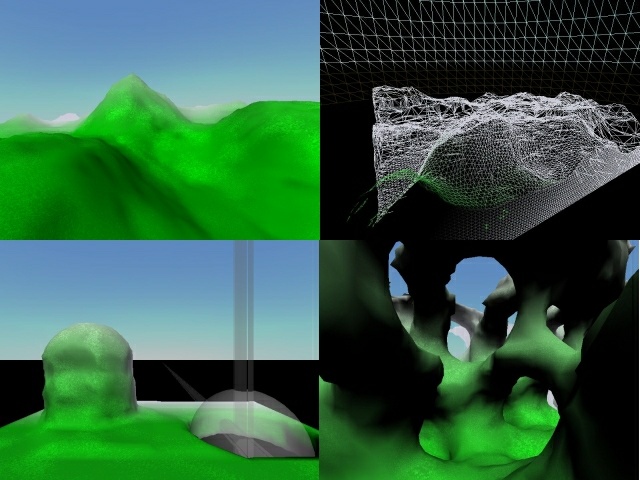 |

Submitted by , posted on 17 March 2001
|
 |

Image Description, by

These are some screenshots from an engine I've been working on for over
a year called Geek. This engine dynamically generates a mesh from a
3D voxel data structure. The voxel structure used to create these
images was 128x128x128. I plan on supporting a voxel structure of
65536x65536x65536. I have a long way to go before I can call it
complete. I plan on adding a portal basted indoor engine also. A
friend of mine is writing a scripting language for it. Check out the
website for more details.
Going clockwise, the top right picture shows some terrain that fades
into fog. The next image is a wireframe showing LOD in action. Note
the more distant terrain has fewer triangles. My cost function for
generating the LOD sucks but will be improved soon The next image is
what I like to call "green swiss cheese". This model is created using a
perlin noise function. The final image shows real-time editing. (Still
not as real-time as I would like). When you modify the voxel structure
all affected meshes and textures are recalculated allowing you to see
your changes immediately.
The engine and the editor are the same. My goal is to have an engine
that allows for real-time map deformation. Imagine throwing a bomb and
find a hole in the ground where it landed, along with being able to see
the grass on the edge and the dirt under the grass from where the bomb
exploded. Well that's my goal anyway, hope I can get that far.
Current features include:
Underlying data structure are voxels contained in an octree.
Dynamically Generated Mesh, Textures, and Texture coordinates.
Terrain doesn't have to be flat. It can have holes and caves in
it easily.
Allows modifying of the voxels which in turn causes all affected
meshes to be recalculated.
Real time editing (this is still slow, but hasn't been optimized
yet)
Early LOD, as you move farther away I use lower resolution meshes.
Saving and Loading of all data structures.
Preliminary console implemented.
Implemented in C++ and OpenGL under Linux
Currently only tested on TNT2 and Geforce2MX
Multithreaded (Except can't run in MT mode on SMP machines running
NVidia drivers, bug in drivers).
Sky sphere has been implented.
I'm sure there is more, but I don't remember.
You can download the linux executable (Mandrake 7.2) and see more
screenshots at http://home.jam.rr.com/jstrohm/projects.html.
I'm most proud of the dynamic texturing. I can take a OpenGL texture
and generate texture coordinates to wrap it around an arbitrary
surface. I'm not talking about projection mapping, but I am able to
give every triangle it's own area of the texture image and still
generate triangle strips that can quickly be fed thru OpenGL. On my
TNT2 I can get between 1 and 1.5 million triangles a second. Once some
of the driver features that are available under windows for the Geforce2
are implemented under Linux I should be able to get 5-8 million
triangles a second on a Geforce2MX.
Thanks for any comments and constructive criticism,
Jack Strohm
|
|

